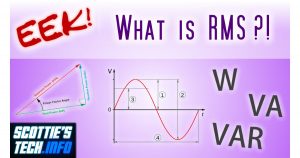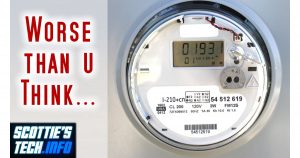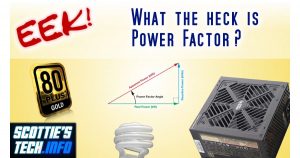20 September 2022 | Energy, How Does it Work?, Video |
 Dirty Electricity is when all our wondrous gizmos generate noise that couples to the human body from the electrical wiring in our homes, schools, places of work, and so on.
Dirty Electricity is when all our wondrous gizmos generate noise that couples to the human body from the electrical wiring in our homes, schools, places of work, and so on.
Fortunately, there are simple filters you can get that reduce the dangers from this type of noise.
UNfortunately, you need to be careful using these filters if you have a backup generator!
Join me for a look at one of the pitfalls of D.E. filters…
(more…)
10 April 2018 | EEK!, Energy, How Does it Work?, Video |
 You probably do this all the time, but you don’t even know it.
You probably do this all the time, but you don’t even know it.
I’m talking about AC power calculations with P = V x I.
Technically, it works. But when you think about it, it shouldn’t. AC has constantly changing voltage and current over time – unlike DC.
So how on earth does it work?
Well, the short version is: RMS, or root mean square!
(more…)
27 February 2018 | Energy, How Does it Work?, Video |
 I recently learned the hard way what’s happening with smart meters in Europe. The same type of smart meter they’re using here in France has already been deployed in many EU countries.
I recently learned the hard way what’s happening with smart meters in Europe. The same type of smart meter they’re using here in France has already been deployed in many EU countries.
Mostly, we hear only about the negative health effects of wireless smart meters, but the ones here only send data back over the power lines.
Nevertheless, it turns out smart meters here are still being used to pretty much screw many over.
In short, smart meters may mean less juice to power stuff, and more frequent main breaker trips as people exceed their (now reduced) capacity.
(more…)
7 August 2017 | EEK!, Energy, Video |
 Power factor is one of those things that sounds really complicated, but it’s pretty simple when you boil it down. And every now and then, knowing a little something about power factor comes in handy.
Power factor is one of those things that sounds really complicated, but it’s pretty simple when you boil it down. And every now and then, knowing a little something about power factor comes in handy.
In short, power factor is the ratio of the real power consumed by a gizmo to the apparent power needed to be generated and delivered by the power company.
The reason for this “extra power” from the power company is the inductance and capacitance in your gizmo that results in shifting the AC current sine wave away from being perfectly in sync with the voltage sine wave.
You don’t really need to understand how all that works; just watch the vid to see why it matters!
(more…)
9 December 2012 | Energy, Gizmos, How Does it Work? |
 These days, it’s all about energy efficiency.
These days, it’s all about energy efficiency.
In some countries, you can hardly even buy normal incandescent light bulbs any more. You are left with a choice of slightly more efficient “a bulb inside a bulb” halogen options, or compact fluorescent light (CFL) bulbs.
Well, there are some problems with CFL bulbs, as we shall see.
Now, LED bulbs have made their big debut on the scene. They use even less power than CFLs, and supposedly they are better for the environment and all that jazz.
In some ways, this is true – but at a cost unless you are careful about which LED bulbs you pick.
And, since LED bulbs are so darn expensive, you need to choose wisely. Here’s how…
(more…)
 Dirty Electricity is when all our wondrous gizmos generate noise that couples to the human body from the electrical wiring in our homes, schools, places of work, and so on.
Dirty Electricity is when all our wondrous gizmos generate noise that couples to the human body from the electrical wiring in our homes, schools, places of work, and so on.



 These days, it’s all about energy efficiency.
These days, it’s all about energy efficiency.
Recent Comments